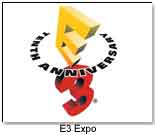 The Electronic Entertainment Expo (E3Expo), held May 11-14 in Los Angeles, is not the only place to find the hottest video games, it is a forum for new ideas, policies, and education for the electronic interactive industry. Its huge trade show floor showcases a smorgasbord of electronic media from 400 companies in 70 countries.
The Electronic Entertainment Expo (E3Expo), held May 11-14 in Los Angeles, is not the only place to find the hottest video games, it is a forum for new ideas, policies, and education for the electronic interactive industry. Its huge trade show floor showcases a smorgasbord of electronic media from 400 companies in 70 countries.
"E3Expo showcases over a thousand never-before-seen products, as well as thousands of the latest titles across all categories," says Carolyn Rauch, senior vice president of the Entertainment Software Association (ESA), the organization behind E3Expo. "If retailers want to know what their customers will be expecting to see on store shelves and purchase for the holidays, E3Expo offers first-time, hands-on access to those products."
The world´s largest electronic interactive media trade show began ten years ago, showcasing games with the then cutting-edge 16-bit technology and edgy 3D graphics. "Every major video game platform introduced since the show launched in the mid-1990´s was seen first at E3Expo,” says Rauch. “Beyond that, there have been thousands of titles and technologies introduced, some of which are among the most popular games and products of all time."
Today, with PDAs and mobile phones, as well as game consoles, computers, and the internet, the industry has exploded, bringing gaming and educational possibilities to anyone, anywhere, anytime. "At this show you´ll see the best software for the existing platforms, as developers have had time to stretch the technology to its limits,” according to Rauch. “You´ll hear more about the introduction of the two new handheld game products from Sony and Nintendo; and you´ll see the latest in growing technologies like online games, wireless, and so forth."
All of these products come to the trade show floor through the work of ESA, which supports the interactive game industry through business and consumer research, as well as First Amendment and intellectual property rights protection. ESA members account for 90% of the 7 billion dollar software entertainment industry in the United States. Of computer game sales, children’s entertainment and family entertainment games were most often purchased, followed by strategy, shooting, and role-playing games. Sports titles, racing, adventure, and simulation games made up 17.6%.
For game console sales, which sold five times as many titles as computer games, action and sports were the big sellers (44.7%), with racing games, role-playing, fighting, family, and shooting games trailing. Importantly, for toy retailers, 54% of all of interactive game sales were titles rated "E" for Everyone, and a third of all sales were geared for players under 18.
***After E3 … Post Show Buzz …
Nintendo and Sony both debuted new handheld devices.
Sony’s PlayStation Portable (PSP) has similar capabilities to PS2 but in portable form, including music and stereo speakers, video and 3D graphics. It features a 4.3 inch color screen and has wireless Internet capabilities. The device is set to be released in spring of 2005 in the United States and Europe, and an end of the year, 2004 release in Japan.
Nintendo adds on to its handheld series with Game Boy DS. The new Game Boy flips open with dual screens (DS) in color. The Game Boy DS plays Game Boy Advance games but the new handheld’s features aim to provide a unique game-play experience, using dual screens, touch screen, and Wi-Fi for multiplayer capability.
Some new video games might inspire gamers to become more active.
Sony’s DK Bongo drum control for GameCube allows players to drum along in games, and to music with Donkey Kong.
An exercise bike will be available to hook up to PS2. The GameBike is by Cateye Fitness and allows the player to navigate through games by steering and pedaling the bike.
Golf fanatics can practice their swing indoors during a rainy day thanks to the Indoor Golf Simulator by QMotions-Golf ($250). The simulator connects to a home computer and does not include golf clubs.

